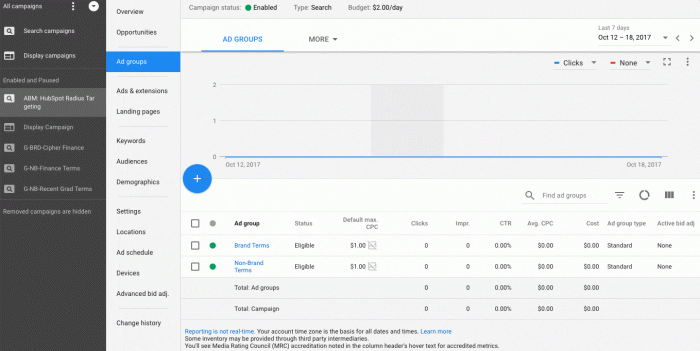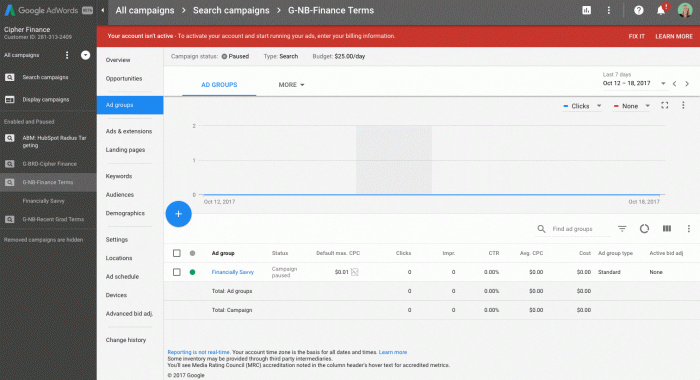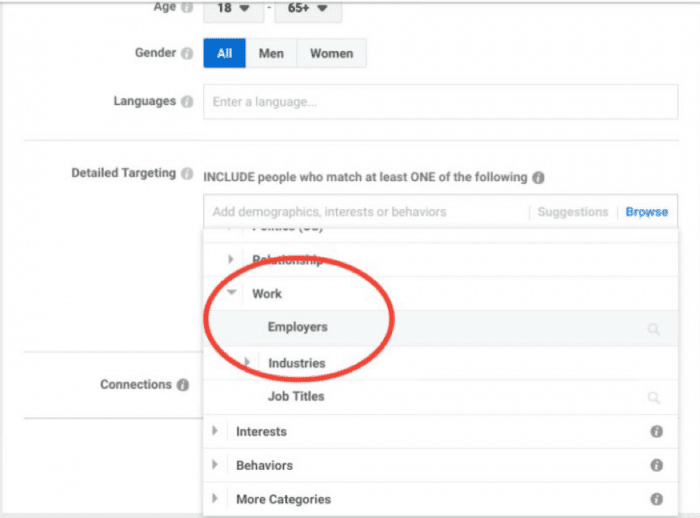Practical guidance on engaging individual companies
Account-based marketing (ABM) campaigns can come in all shapes and sizes. Depending on the companies that make up the target list, the tactics can be an almost limitless blend of online and offline activity.
Regardless of how that blend is, erm, blending for an individual company, 9 times out 10 you’re going to want the individuals who work at your target accounts to come to your website at some point soon.
As learned readers of Smart Insights, no doubt you’re at least up to speed with the fundamentals of SEO and have consumed one of the dozens of articles on inbound. But ABM is different. We’re not trying to bring in as many visitors as possible, we’re trying to bring in as many as possible from our account list.
This slight difference in the challenge brings its own blend of tactics that we’re going to explore in this article.
Warning, if you think account-based marketing is the type of buzzword that should be avoided, it’s just the tip of the iceberg. Hold on tight!
Content is king
Before we get into the nitty-gritty of tactically reaching your accounts, you need to make sure you have the right content. The whole point of ABM is that you’re undertaking the right type of activity to individual companies, or small groups of companies; the activity that will give you the best possible chance of winning their business.
Depending on your circumstances, that might mean creating individual campaign assets: infographics, landing pages, banner ads for individual accounts. It might mean grouping accounts.
Either way, that’s a moderately long-winded way of saying it starts with the content. Make sure you dedicate the time creatively to thinking what is the best type of content and what is the optimum medium to deliver that content.
As the rest of the article is focused on things that work, in the interest of ‘keeping it real’ here are a couple of things that – in my experience – don’t work so well:
- Cold emails – email marketing does work on ABM campaigns, but not until much later in the sales process. That’s because personalization at the subject line level has been done for 15 years. Even if it’s well crafted and careful, it still looks spammy, which makes you unlikely to get a return from it. The concern here is that it may end up detracting from the rest of the campaign and do more harm than good. There are better options to get people to your website.
- Telemarketing – again it can work, but calling people up and asking them to visit your website is a surefire way to hack them off. Not a great approach in the main.
Account-based advertising – Google AdWords
If you work with a Pay Per Click (PPC) agency, or happen to be somewhat of a Search Engine Marketing (SEM) ninja yourself, there are options when it comes to Google AdWords.
It’s worth pointing out, neither of the following approaches are where they need to be at the moment. Google isn’t really at the party yet when it comes to ABM, so here we’re really taking some broader tools they have and hacking them a little to endeavour some sort of fit into our wider ABM methodology.
Radius targeting
Here we’re 100% in hack territory. I doubt when Google’s product engineers were dreaming up the concept of location targeting all those years ago they had anything in mind other than retail. But times they are a changin’, and we’re all about ABM.
Luckily, you can make Radius Targeting (Google’s posh word for location targeting) work from an ABM perspective with a little bit of list-love.
You’ll have to build a list out with a company’s address, then use Radius Targeting to aggressively go after top spot within a mile radius of your target accounts.
OK – it’s far from a perfect science – as you’re going to almost certainly end up with some bleed into other organizations, but if your ABM campaign is focused on regional clusters of companies, this could actually work pretty well.
If you want to create a specific campaign for ABM, make sure you remove the default location – which will usually be the country you operate out of. Otherwise, it won’t be very targeted!
*click gif above to see how radius targeting works*
Source: Hubspot
Customer match
Customer match gives you the chance to serve specific ads to contacts from your CRM or Marketing Automation System (MAS).
It’s a good fit for ABM campaigns as it means you can broaden personalization campaigns beyond landing pages and email campaigns into Google Ads too. As a 36-year-old dad, this passes as ‘cool’ nowadays for me.
If you want to put a list into Google AdWords for customer match, and you’re using the ‘old’ Google AdWords experience, all you’ll need is the email address in a CSV file and then do what Google says.
On the new version there’s more matching – including Phone Numbers, Address and Mobile Device ID and your CSV would need to reflect this in the formatting.
If you follow the handy GIF below, you can see how to get this rolling.
*click gif above to see how radius targeting works*
Source: Hubspot
One pitfall of my first experience with it was an inability to do anything with it once it’s imported. It would be really handy to be able to segment the list further once in AdWords, but you can’t. So seperate lists for separate campaigns.
This is clearly a pain in the arse if you have a typical ABM target list of between 50 to 200 accounts, which is what we recommend for the vast majority of clients.
Not as much of a pain in the arse as the minimum list size though. You need to have at least 1000 matched contacts to upload a list. It’s not enough to have a list of 1000 – Google’s gotta know who they are.
Frankly, this is the bit that Google needs to catch up on and a pitfall of using what is ultimately a retargeting tool for ABM. Even if an organization has 200 accounts on their target list, which would be above what I would recommend, they would need 5 contacts that could be matched per account.
Taking a DMU (Decision Making Unit) perspective on things, getting that consistently applied across all the accounts is really going some.
If you do make it as far as having a list uploaded and accepted you can set about doing the usual AdWords stuff on keywords, ad text, display ads and the like. Obviously, as ABMers, we are gonna want to do a custom landing page too! For when they actually reach our site!
ABM advertising – Paid social
Facebook and Linkedin are the commercial darlings of the social media world purely because they’ve been able to monetize their audience with nifty ad programmes.
Luckily, both allow some love for ABM, which makes me love them with all of my digital might.
Obviously, the channel preference will depend on the market the account sits in, the culture and dynamic within the organization, the demographic of the decision-making unit and all the rest of it.
If you were belt and braces, and your marketing budget is bursting at the seams off the back of consistently great ROI performances, you’d do both just for the hell of it.
Anyway, into the detail we go…
Much like Google, there’s more than one way to get it done on Facebook.
You can use Facebook Custom Audiences to upload a list of email address and phone numbers and to target. That’s cool if you’ve got them.
Our preferred way, because of the ability to reach companies at scale with minimum fuss, is the Workplace Targeting. You don’t think Facebook is just being helpful providing that ‘Works At’ bit on your profile do you? Allowing advertisers to monetize their platform is a key part of their master plan for (continued) global domination.
To have a crack at this, get your campaign assets created/built out, sort the ad text, and jump right into the targeting.
Search out the Workplace header under the More Demographics section. Click Work and then select Employers. Account-based advertising made easy right there.
It’s a really slick way of creating ABM ad campaigns and depending on the brand can give one of the best ways we’ve found of getting someone to visit your website. What is it about Facebook ads that make them so damn clickable?
Let my credit card know if you find out, will you? Either way, we care here about getting them to your website and this approach definitely works.
Account targeting using LinkedIn ads is pretty damn straightforward. Woohoo!
First, create your CSV list with just a single column. You then create a row for each account on your target list and make sure your header is “companyname” as the first one.
Secondly, on the audience creation page in Campaign Manager, click Create an audience. Choose ‘Match based on a list of accounts’. Upload your file, and click Next.
It’s really that easy and straightforward. And because LinkedIn not only understands ABM, but has been a driving force behind it for the last few years, it really does work extremely well.
The other benefit with LinkedIn is that there’s broader value on the account-based social side of things with LinkedIn Sales Navigator providing a handy way to directly engage with your contact at named accounts to drive them to your website.
ABM advertising – ‘Organic’ social
Seems odd saying organic because there’s a hell of a lot of proactive time going in to getting a campaign off the ground, with success, using free tools from companies who exist in the main nowadays to stop you using their free tools (hello Facebook).
While it’s clearly part of a wider consideration of the social platforms we just discussed, it’s worth splitting this off into a separate section as it’s a different tactical blend because it’s not paid. It’s leveraging the free tools and using your noggin to get it done.
Obviously coupling this up with the ads is something you’ll almost certainly want to consider. Who doesn’t want to load activity up to supercharge results after all? But we live in a world with walls and you’ve got to put them up somewhere to maintain some degree of structure with your plans.
The bottom line here is that you don’t necessarily have to pay to get your desired accounts to visit your website from social media. When you view opportunities through an account-based social lens, the sky’s the limit.
Here are a couple of bits to chew on:
Get more from multimedia
Social networks are more multimedia than ever. Personalised videos can work really well at getting people to your website. There are some great free platforms that allow you to get a video down really quickly with great results.
Two Chrome plugins are amongst my favourite: check out Soapbox and Loom. Both offer a variety of different features, so one is sure to fit your flow better than the other.
Use the right social media platform to engage them and Bob’s your uncle.
The competitive type
You can inject a dose of ABM into some social media competitions and they get a life of their own.
For one client, we identified the movers and shakers within the DMU of their target list. We then undertook some direct outreach to encourage entries from as many relevant people within the list as possible. Obviously, it was open to everyone else in the interest of fairness.
After the best team had won, a programme of account-based social activity was launched to profile the incredible win. This then lead to shares and engagement not only from the winners, but also the corporate accounts of the brand they represented.
It also got picked up by a hawk-eyed internal comms team and profiled on their internal Slack channel and internal newsletter. This resulted in numerous website hits from the corporate domain and gave a strong platform to incorporate wider work into the mix.
ABM Advertising – Ad networks
Ad networks have historically been monopolized by major media companies, and as such came with a major price tag, Obviously, the internet came about, and, while it’s taken a little time – there has been disruption in the media buying space.
Luckily for us, as ABM practitioners, some of that disruption has included things we’re bothered about. Hooray!
There are cool independent, self-service digital advertising software vendors out there. Here are two we’ve worked with and feel comfortable recommending. They both have their respective merits.
Choozle
There are a couple of different account-based targeting options using the Choozle platform that are handy for getting your account list to your website.
CRM matching
You can use CRM matching to upload a file from your CRM or MAS). Frankly, this works very similarly to Customer Matching in AdWords. Once in Choozle, you can then fiddle around with it to your heart’s content to build a specific ad campaign targeting companies, or groups of companies, with simplicity and at scale.
IP targeting
Choozle also supports targeting of companies using IP-to-Company matching. As most businesses have a static IP address for their premises, Choozle have cleverly supported the targeting of specific companies available through this medium.
It’s something that’s been proven to work in the field of ABM website personalization with tools like ABM for WP, so it’s great to see this as a technical option to get people to your website too. An effective way to reach accounts for whom you have no CRM or MAS data.
Choozle supports both direct media buying and an agency model. A monthly subscription starts at just $99 a month, which when you consider how high traditional barriers are in running campaigns like this at scale, represents good value for money.
Albacross
Albacross is the new kid on the block. Boasting an elite board, including the Nordic CEO of Facebook, they are aggressively out in the market flying the flag for the Europeans. Their model is purposefully disruptive and has the staid lead generation market for reasons that will become clearer shortly.
With Albacross, again you manage ads promoting your website yourself. If the barriers to entry are low for Choozle, they’re almost indistinguishable on the Albacross platform. It’s free to sign up. Above that, it’s free to use their website visitor identification tool – which is a ground well-trodden by a number of other players whom I won’t mention here because THEY NEVER STOP SPAMMING ME. You probably know who I mean though, right?
What’s cool about this model is the end-to-end nature of what they’re doing. Both before and after activity to drive people to your website, you’re gonna want to know who is actually coming to your website.
Once you know who is coming to your website, from which channels, and what they did, you can then decide to target them with a specific ad campaign when they’re browsing news sites in the big, wide internal-world.
They mean business – it’s really slick and easy to use. The fact that it doesn’t cost anything to get set up and you can be off and running with website promo ads with tiny amounts of spend that you completely control, all backed by the normal reporting you would expect on impressions is impressive stuff.
It’s giving us a lot of what we need back and it’s a style of all-in-one closed loop reporting that us ABM practitioners have been craving for a while.
So there you have it
Lots of ground covered and we’ve gone into enough depth to give you an idea of how each tactic can work well in certain situations.
Much like everything else in marketing nowadays, finding the right tactical blend to bring the accounts you’re targeting to your website is going to take some trial and error. Keep measuring and learning and you’ll keep moving forward.



